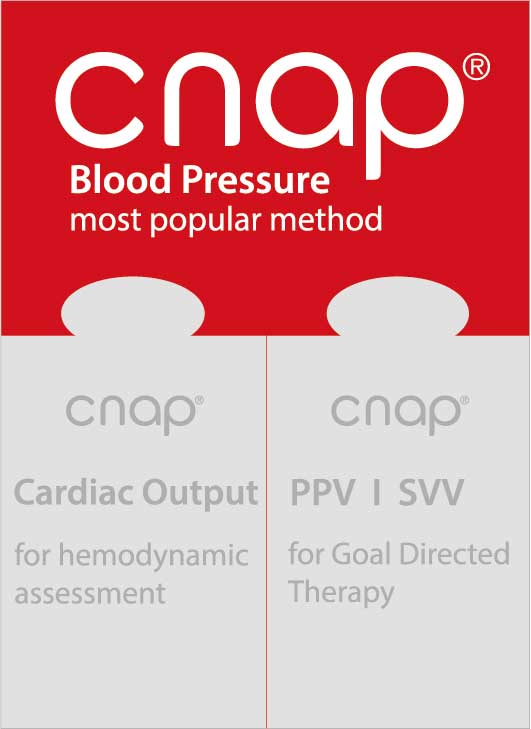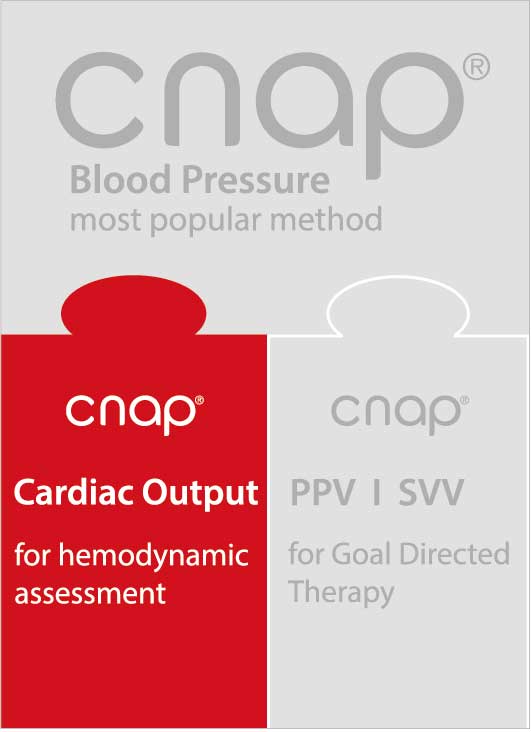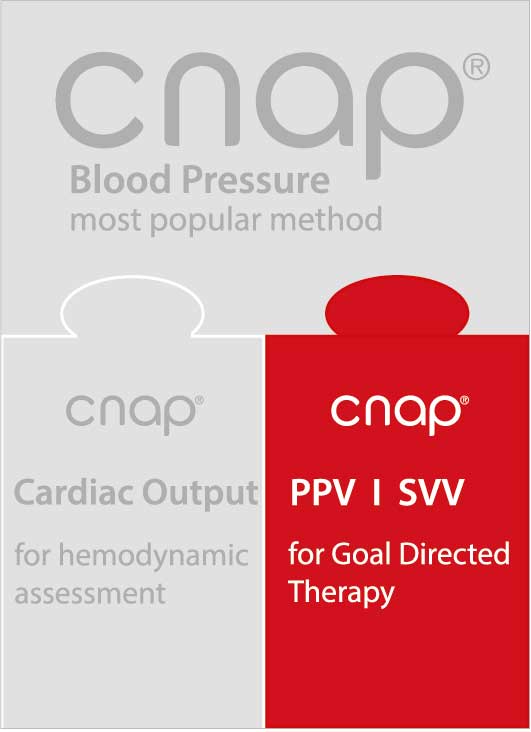CNAP® Technology
Full hemodynamics
at your fingertips
Bridging the gap with non-invasive and continuous parameters
Based on an easy-to-use dual finger sensor, the CNAP® technology provides a full set of non-invasively measured, continuous patient signals and hemodynamic parameters:
- CNAP® blood pressure (waveform, Sys, Dia MAP, PR)
- Advanced hemodynamics: Cardiac Output (CO/CI), Stroke Volume (SV/SI), Systemic Vascular Resistance (SVR/SVRI)
- Dynamic fluid management parameters: Pulse Pressure Variation (PPV), Stroke Volume Variation (SVV)

Non-invasive
Continuous and non-invasively measured data in real-time without any risk and burden to patients.

easy-to-use
Due to the quick and easy set-up of the unique CNAP® finger sensor, measurements are up and running in 1.5 minutes.

Reliable & Proven

Trusted
More than 5,500 customers worldwide and leading global partners trust in our 20 years of experience.
You are currently viewing a placeholder content from Vimeo. To access the actual content, click the button below. Please note that doing so will share data with third-party providers.
More InformationFull hemodynamic picture

Continuous Blood Pressure
CNAP® blood pressure is measured non-invasively on the patient’s fingers by using the unique CNAP® finger sensor.
Continuous blood pressure measurement allows for the detection of rapid blood pressure changes often unidentified, missed or only belatedly recognized with intermittent NBP upper arm measurement.
One or more hypotensive episodes were detected during complex gastrointestinal endoscopy in 29% of the patients by using CNAP® technology. (1)
“Continuous non-invasive arterial pressure measurement facilitates detecting hemodynamic instability more rapidly and therefore may improve patient safety” (1)
- Preventing perioperative hypotension (1)
- Identifying unexpected and transient blood pressure drops in syncopal patients (2)
- Tracking of cardiovascular response to autonomic function tests and stimuli (3)
References:
(1) Nicklas JY, et al. Continuous noninvasive arterial blood pressure monitoring using the vascular unloading technology during complex gastrointestinal endoscopy: a prospective observational study. J Clin Monit Comput. 2019 Feb;33(1):25-30. doi: 10.1007/s10877-018-0131-6. Epub 2018 Mar 20. PMID: 29556885.
(2) Frith J, Bashir AS, Newton JL. The duration of the orthostatic blood pressure drop is predictive of death. 2016 Apr;109(4):231-5. doi: 10.1093/qjmed/hcv126. Epub 2015 Jul 9. PMID: 26163077.
(3) Cieslak M, et al. Quantifying rapid changes in cardiovascular state with a moving ensemble average. Psychophysiology. 2018 Apr;55(4). doi: 10.1111/psyp.13018. Epub 2017 Oct 3. PMID: 28972674

Non-invasive Cardiac Output & advanced hemodynamics
The non-invasive CNAP® finger sensor allows for accurate(1) and immediate feedback on hemodynamic and cardiovascular status in perioperative settings to support therapeutic decision making, and also to quantify hemodynamic response during orthostatic and autonomic function tests (tilt table, active standing, Valsalva, etc.)(2) or to track cardiovascular response to autonomic function test and stimuli (3).
References:
(1) Wagner et al. (2018). A comparison of volume clamp method-based continuous noninvasive cardiac output (CNCO) measurement versus intermittent pulmonary artery thermodilution in postoperative cardiothoracic surgery patients. J Clin Monit Comput. 2018 Apr;32(2):235-244. doi: 10.1007/s10877-017-0027-x. Epub 2017 May 24. PMID: 28540614.
(2) Buszko, K., et al. (2018). The complexity of hemodynamic response to the tilt test with and without nitroglycerine provocation in patients with vasovagal syncope. Scientific Reports, 8(1), 14554.
(3) Cieslak M, et al. Quantifying rapid changes in cardiovascular state with a moving ensemble average. 2018 Apr;55(4). doi: 10.1111/psyp.13018. Epub 2017 Oct 3. PMID: 28972674

Non-invasive Pulse Pressure Variation and Stroke Volume Variation parameters
PPV and SVV are dynamic fluid parameters enabling individualized intra-operative fluid management, supporting healthcare professionals in educated therapy decisions(1,2) over the course of Enhanced Surgical Recovery (ESR) and Goal Directed Therapy (GDT) guidelines to minimize postoperative complications(3,4).
References:
(1) Benes, J et al. Fluid management guided by a CNAP device is associated with decreased postoperative morbidity after total knee and hip replacement.BMC Anesthesiology, 15(1), 148.(2015)
(2) Renner J et al. Non-invasive assessment of fluid responsiveness using CNAP™ technology is interchangeable with invasive arterial measurements during major open abdominal surgery. Br J Anaesth. 2017 Jan;118(1):58-67. doi: 10.1093/bja/aew399. PMID: 28039242.
(3) Michard, F., Biais, M., Lobo, S. M., & Futier, E. (2019). Perioperative Hemodynamic Management 4.0. Best Practice & Research Clinical Anaesthesiology
(4) Nicklas JY, et al. Personalised haemodynamic management targeting baseline cardiac index in high-risk patients undergoing major abdominal surgery: a randomised single-centre clinical trial. Br J Anaesth. 2020 Aug;125(2):122-132. doi: 10.1016/j.bja.2020.04.094. PMID: 32711724.
OUR PRODUCTS WITH INTEGRATED CNAP® Technology
Non-invasive monitoring of blood pressure and advanced hemodynamics for medium and low-risk surgery.
Setting new standards for autonomic function testing and syncope assessment.
Hemodynamic measurement just got easier – integration or interfacing

